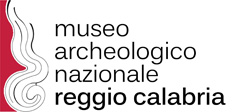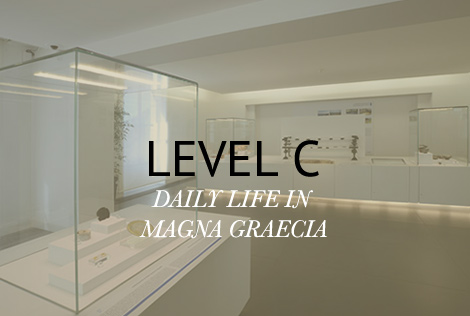In the aftermath of the catastrophic earthquake of 1908, which destroyed the city, Paolo Orsi developed the idea of building a large National Institute as a permanent museum dedicated to ancient Greece in Reggio Calabria. The project took shape in 1954 with the merger of local collections and state ones.
The new permanent exhibition, which originated from the remodeling of the building that started in 2009, features 220 displays and is divided into four levels, which tell the story of the human population in prehistoric times until Roman Calabria, in chronological order. The visit begins on the second floor (level A – Prehistory and Protohistory, the Age of Metals), continues on the first floor (level B – Cities and sanctuaries of Ancient Greece), on the mezzanine (level C – Necropolis and daily life of Ancient Greece : Sybaris and Croton, Hipponion, Kaulon, Ciro Laos; and ends on the ground floor (level D – Reggio), where it is placed the room of Riace and Porticello Bronzes, in a setting equipped with an air-conditioning and an anti-seismic system, which can be accessed after a brief stop at the grape room and at the antipollution filter area. The floor of the basement (level E) is reserved to temporary exhibitions.
In 1981, the section intended to receive the famous Bronzes, the two statues discovered in 1972 in the Riace Marina (Reggio Calabria) seabed, along with the so-called bronze sculpture Head of a Philosopher, recovered in the Strait of Messina, in Porticello (Villa San Giovanni), and the so-called Head of Basel, has been prepared. These are the findings more known throughout the world, although they are not the only precious examples of the history of Calabria. In fact, as with the Museum of Bronzes, there are exhibitions related to a broad time span, from Prehistory to the Roman Age, some of them unique in their beauty, grandeur or condition.
In the MArRC there are even traces of the first presence of Homo erectus in our peninsula, about a million years ago. From the important archaeological site of the Grotta of the Romito of Papasidero, two skeletons, which date back to the Paleolithic, were found. Not far away, in the same cave, a stone was found with an engraving of the Bos primigenius Taurus (dated to 12,000 years ago), one of the first and oldest examples of stone art in Italy, whose cast is on display at the Museum.
Since the Neolithic Age, there have come down to us wonderful daily-use tools, such as axes and knives used in agriculture, or objects for female beauty, like ointment and a beautiful bag of cosmetics for makeup, which still contain the remains of powders and eyeshadows (up to 4000 years ago). Jewels and tools of work of women in the age of bronze and iron (the second millennium to 700 BC), along with pottery and various metal objects…





